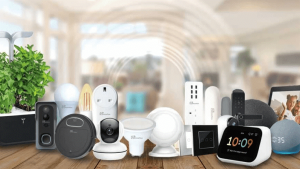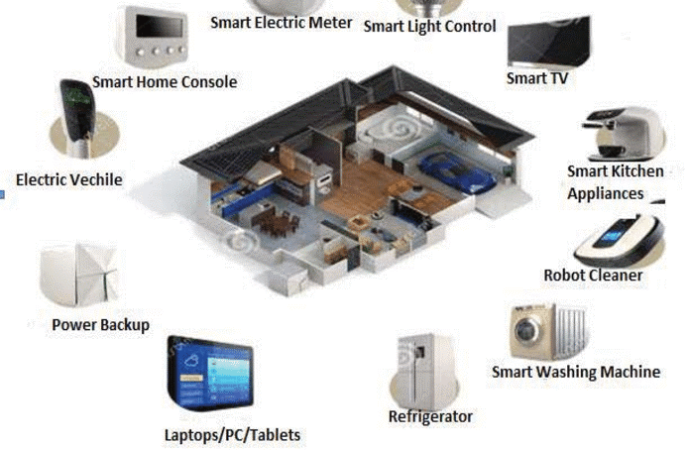The Future of Smart Home Devices 2024 Trends and Innovations In the rapidly evolving world of technology, smart home devices have become a cornerstone of modern living. These devices not only enhance convenience and security but also contribute to energy efficiency and overall quality of life. This article explores the top smart home devices available
The Future of Smart Home Devices 2024 Trends and Innovations
In the rapidly evolving world of technology, smart home devices have become a cornerstone of modern living. These devices not only enhance convenience and security but also contribute to energy efficiency and overall quality of life. This article explores the top smart home devices available today, providing a comprehensive analysis and comparison to help you make informed decisions for a smarter home.

Gadget.com
Introduction to Smart Home Devices
Smart home devices are electronic gadgets that connect to the internet or a local network to offer automation, remote control, and advanced features that improve the functionality of your home. From smart thermostats and lighting to advanced security systems and voice assistants, these devices integrate seamlessly to create a more efficient and connected living environment.
- Smart Thermostats
Overview
Smart thermostats are designed to optimize heating and cooling in your home. They learn your preferences and adjust the temperature accordingly, which can lead to significant energy savings. Popular models include the Nest Learning Thermostat, Ecobee SmartThermostat, and Honeywell Home T9.
Features
- Learning Capabilities: Many smart thermostats can learn your schedule and preferences to adjust temperatures automatically.
- Remote Control: They can be controlled via smartphone apps, allowing adjustments from anywhere.
- Energy Reports: Provide insights into energy usage and offer suggestions for savings.
Pros and Cons
| Pros | Cons |
| Energy savings | Initial cost can be high |
| Convenience of remote control | Requires a stable internet connection |
| Learning and adapting features | May require professional installation |
- Smart Lighting
Overview
Smart lighting systems provide the ability to control your lights remotely and customize settings such as brightness, color, and scheduling. Popular brands include Philips Hue, LIFX, and Wyze Bulbs.
Features
- Remote Control: Lights can be controlled through apps or voice commands.
- Customization: Adjust colors and brightness to suit your mood or time of day.
- Scheduling: Set schedules for automatic on/off times.
Pros and Cons
| Pros | Cons |
| Energy efficiency | Can be expensive |
| Customizable ambiance | Requires smart hubs or bridges |
| Convenience and automation | Potential compatibility issues |
- Smart Security Systems
Overview
Smart security systems offer advanced features for home safety, including cameras, motion sensors, and doorbell cameras. Leading products include the Ring Video Doorbell, Arlo Pro, and Google Nest Cam.
Features
- Real-Time Monitoring: Live video feeds and alerts for suspicious activity.
- Integration: Works with other smart home devices and voice assistants.
- Remote Access: Control and view your security system from anywhere.
Pros and Cons
| Pros | Cons |
| Enhanced security | Privacy concerns |
| Integration with other devices | Subscription fees for advanced features |
| Real-time alerts and monitoring | Initial setup can be complex |
- Smart Speakers and Voice Assistants
Overview
Smart speakers and voice assistants, such as Amazon Echo, Google Nest Audio, and Apple HomePod, serve as central hubs for controlling other smart devices through voice commands. They also provide entertainment, information, and connectivity.
Features
- Voice Control: Manage other smart devices, play music, and get information using voice commands.
- Integration: Compatible with a wide range of smart home devices and services.
- Smart Assistant: Access to virtual assistants like Alexa, Google Assistant, or Siri.
Pros and Cons
| Pros | Cons |
| Hands-free control | Can be intrusive to privacy |
| Integration with numerous devices | Audio quality varies |
| Provides useful information | Dependence on internet connection |
- Smart Plugs and Switches
Overview
Smart plugs and switches allow you to control ordinary appliances and lighting remotely. Brands like TP-Link Kasa, Wemo, and SmartThings offer a range of options.
Features
- Remote Control: Turn devices on or off via smartphone apps.
- Scheduling: Set schedules for when devices should be powered.
- Energy Monitoring: Track energy usage of connected devices.
Pros and Cons
| Pros | Cons |
| Affordable | Limited to devices with plugs or switches |
| Easy to install | May require additional hubs |
| Adds automation to non-smart devices | Can interfere with other devices if not properly managed |
Comparative Analysis
To aid in selecting the best smart home devices, we present a comparative analysis of key features, advantages, and potential drawbacks.
Comparative Table
| Device Type | Key Features | Advantages | Disadvantages |
| Smart Thermostats | Learning capabilities, remote control, energy reports | Energy savings, convenience, adaptability | High initial cost, requires stable internet |
| Smart Lighting | Remote control, customization, scheduling | Energy efficiency, ambiance control, automation | Expensive, requires hubs or bridges |
| Smart Security Systems | Real-time monitoring, integration, remote access | Enhanced security, integration with devices | Privacy concerns, potential subscription fees |
| Smart Speakers | Voice control, integration, smart assistant | Hands-free control, broad compatibility | Privacy concerns, variable audio quality |
| Smart Plugs/Switches | Remote control, scheduling, energy monitoring | Affordable, easy to install, adds automation | Limited to plug-in devices, potential hub requirements |
The Future of Smart Home Technology
As we look ahead, the future of smart home technology promises even greater advancements and integration. Emerging trends suggest that smart home devices will become increasingly sophisticated, with advancements in artificial intelligence (AI) and machine learning enabling these devices to offer even more personalized and intuitive experiences. For instance, future smart thermostats might not only learn your temperature preferences but also predict them based on factors such as weather patterns, personal health data, and local events. Similarly, smart security systems will likely incorporate more advanced biometric recognition and predictive analytics to enhance home safety and reduce false alarms.
Moreover, the integration of Internet of Things (IoT) technology will enable even more seamless interaction between various smart home devices. For example, your refrigerator could communicate with your smart oven to suggest recipes based on available ingredients or even adjust cooking times for optimal results. The growing emphasis on energy efficiency and sustainability will also drive innovations, leading to smart devices that help reduce carbon footprints and support eco-friendly living practices. As these technologies evolve, we can expect smarter homes that offer greater convenience, efficiency, and integration with our daily lives.
Technological Innovations Shaping Smart Homes
Technological innovations are continually reshaping the landscape of smart home devices, pushing the boundaries of what’s possible. One notable advancement is the development of 5G technology, which promises to revolutionize smart home connectivity by providing faster and more reliable internet speeds. This will facilitate real-time data transfer between devices, enhancing the responsiveness and efficiency of smart home systems. Additionally, the integration of augmented reality (AR) and virtual reality (VR) could transform how users interact with their smart home devices, offering immersive interfaces for control and management.
Another significant trend is the rise of edge computing, which allows data processing to occur closer to the source rather than relying on centralized cloud servers. This will improve the performance and security of smart home systems by reducing latency and minimizing data breaches. Furthermore, advancements in blockchain technology may enhance the security and privacy of smart home networks, offering decentralized control and immutable records of device interactions. As these technologies continue to advance, they will drive the next wave of innovation in smart home devices, making them even more integral to our daily lives and enhancing the overall smart home experience
Conclusion
Smart home devices represent a significant advancement in technology, offering numerous benefits in terms of convenience, efficiency, and security. By understanding the features, advantages, and limitations of various devices, you can make informed choices that best suit your needs and preferences. Whether upgrading your home’s security, optimizing energy use, or simply adding convenience, smart home devices provide innovative solutions for modern living.
By carefully considering the information provided in this article, you can create a smart home environment that enhances your lifestyle while leveraging the latest advancements in technology.
















